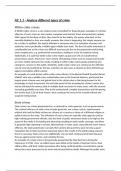Other
WJEC Level 3 Applied Diploma in Criminology | Unit 1
- Course
- Institution
This is my notes for the WJEC Level 3 Criminology Unit 1 Controlled Assessment that got my 100/100. I can assure you these notes are extremely high quality and will help you get full marks just like me. I got 400/400 overall in this course (A*).
[Show more]



